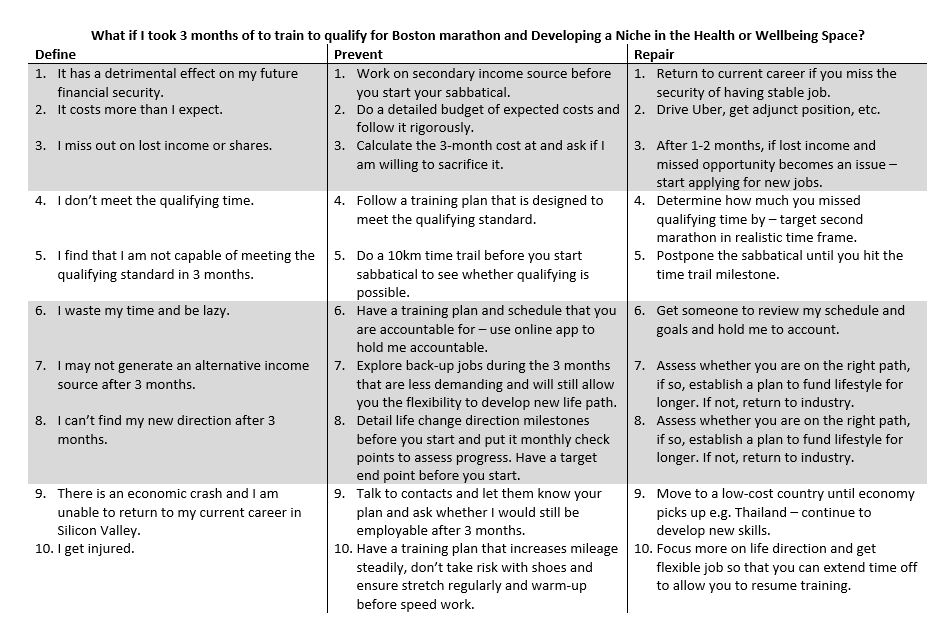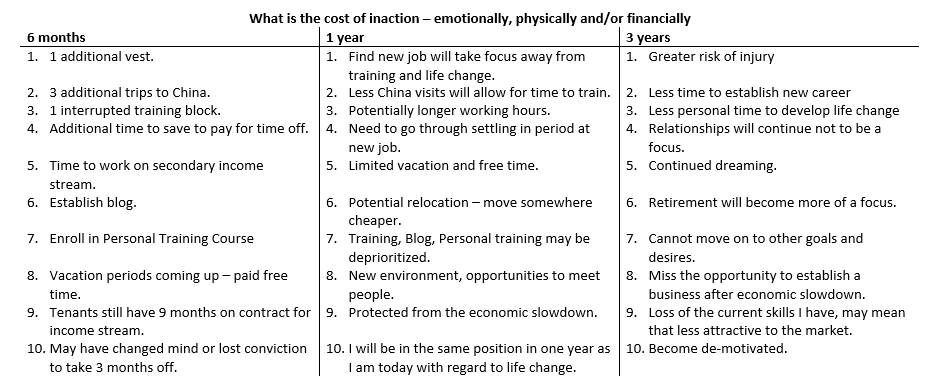Fear Setting
The future is uncertain . . . how many times have we heard that? How many times do we excite ourselves by a new path in life only to be tempered by the realization of our obligations and the comfort of what security has to offer. It is why we stay the course, until we reach that magical confluence of health and wealth to finally live our dreams.
I have made a number of life changes, pursuing my PhD, moving to the USA. They came with their struggles but reflecting back, I am glad of the experience and the ensuing growth. Different life decisions come with their own fears and uncertainties which can paralyze. For instance, upping sticks and taking a job in another country would be easier for me compared to taking time out to mediate on my life path. However, it is the latter that I have been deliberating about.
Investing in myself has always been difficult. A gulf appears between lost income and the expense of sustaining myself that nudges me towards the secure path. However, little things confirm that money invested in personal growth is rewarding and transformational. Do I think about the money invested in joining an expensive gym when I was separated and out of shape? No!!!! Instead, I embraced this lifestyle so much it has become part of my identity. Therefore, I cannot shy away from taking the next step.
I was experiencing a bout of my usual life change deliberation while watching Tim Ferris’ TED talk about defining your fears. It dawned that many of my concerns are just rattling around in my head remaining unarticulated and nebulous. It was then, Tim introduced ‘Fear Setting’, a stoic influenced technique requiring us to premeditate in detail the consequences of taking a course of action. Our biggest fears are said to be imaginary and the specificity of this exercise allows us to evaluate them pragmatically.
So here we go! What is the action I am in fear of taking? It is taking 3 months out to train for a Boston Marathon Qualifying attempt and to develop a niche in the Health or Wellbeing space. And then? Write down my fears, ranked in importance, of what could happen if I do this. Then for each fear detail how I could prevent it from happening or repair the situation if it does occur.

Well . . . I managed to come up with quite a few fears! Some I knew but many had not progressed beyond a nagging sense of unease. Broadly categorizing them, they fall into security, not achieving my marathon time, not developing a new niche and c’est la vie. Taking the 80/20 rule, and zooming in on my top fears, financial security comes top of the list. It is a fear I have always known because it cuts across my values with regard to work ethic and being able to support myself. It would be very humbling for me if I ever had to ask for money to support myself. So how can I address this fear? Timeframe, location and budget. The 3-month timeframe ensures that I stay relevant and fresh in the memories of potential recruiters should I decide to return to work. Also, I intend to stay in the Bay Area, despite its cost of living in order to stay close to job opportunities in tech. Finally, for budget, I made the resolution not to dip into my life savings but instead to create another saving pot specifically to fund my sabbatical to create mental separation between these two purposes. I then created a detailed budget and added a 25% factor of safety to provide a conservative saving goal I can aim towards and would be comfortable on living off.
For not meeting my marathon target, I need to know that I am capable of achieving it and have the mental strength to stick to my training plan. Both I can assess realistically. Taking my most recent personal best, which is the 5km, using a marathon calculator I find I am 30s away from a benchmark 5km time that would be indicative of a qualifying performance. Also, I know I am capable of coming up with and sticking to a marathon training plan because I stuck to one for 12 weeks before. Therefore, before my sabbatical, I have to keep logging the miles and improve my speed.
Developing a niche in the Health & Wellness space, I need to adopt the same rigor as I do with my marathon training, which is to have a schedule and be accountable to it. Again, it is a practice I am starting now by scheduling my day to have 2 hours in the morning dedicated to personal time and my evening focused on running. This has created some tension with work commitments, but I have found I am more focused during the day to get my tasks done.
Wow . . that was quite an essay . . . but we are not quite there yet. There are still two more steps in this fear setting exercise. Now that we have defined our fears, we need to look at the other side of the coin and articulate the benefits of an attempt at a Boston Marathon qualifying time and developing a niche in the Health & Wellness space. This should be a realistic assessment and focus on me as a person not grand dreams of transformation or material success. So here we go – my list of underplayed benefits.
- I would be a stronger runner as a result of focused training.
- I would be more aware of who I am and where of where I want to go.
- If I fail, I can go back to my career knowing that I gave it a real shot.
- I would be more self-aware and have greater visibility of my blind spots.
- I would have made an attempt at developing a secondary income source.
- I would have gained skills that help me start a career in the fitness/self-development area.
- I would have developed a daily practice that would allow me to work independently.
- I would have built a stronger mindset.
- I would be more capable of forming meaningful relationships.
If I were to summarize the benefits of taking 3 months off, I would liken it to that of intense training where you increase the chances of success in the skill you want to develop in a shorter time period. Considering my current practice with a job in Silicon Valley and a third of my time travelling. My goals get worked upon, but they come with frequent interruptions where my development ebbs and flows. Therefore, this sabbatical offers the chance to accelerate the direction in which I want my life to go and if things did not go to plan I would be a better person as a result and could move forward in my current career with better tools that I can use in my daily life.
Final stage, thought has been given to the reasons why I fear making change in my life, as well as the realistic benefits if I gave it a shot. Now, consideration has to be given to the cost of inaction, what if I did not make the change in 6 months, 1 year, 3 years. You know the drill, same tabular format.

What became clear doing this activity is that the costs of inaction increase greatly over time. Comparing not taking action for 6 months with 3 years, the negatives increase including one glaring one. If I stay on my current path, I am not investing in my engineering skills and while my mindset has improved immensely while working in Silicon Valley, that pace is slowing. Therefore, over time the feeling of stagnation will increase and moving into my 40s my mindset will likely become more risk adverse and I instead my attention will gradually switch towards the finish line of retirement. Therefore, I have to look at the opportunity of now with the positivity I currently have and utilize it.
In comparison not pulling the trigger on my sabbatical for 6 months, the costs are more inconveniences which I am prepared to pay in order to prepare myself for the lifestyle change. Also, it allows me time to both cement my daily practices and also earn to be able to finance my time off in order to address some of my fears and remain true to my values. Finally, I can work towards some realistic milestones – like improving my 10km PR. Therefore, I see the benefit and I can continue working with a set end date in mind and can be comfortable with the sacrifices I make.
What have I learned while doing this exercise? It is that in our head we overplay both our hopes and fears swaying between highs and lows, increasing the risk in making hot decisions whether overly fearful or optimistic. The fearful ones many of us can understand – but the overly optimistic ones are equally as risky – we are not as grounded when we go into things and so less prepared to persevere when things do not go to plan. I always remember the story about prisoners of war, the ones that break first are the overly optimistic ones as they suffer mentally when their hopes fail to materialize. The negative ones at least know they will be there for the long haul and slowly waste away. It is those with the belief that they will get through the struggle that fair the best. This exercise has allowed me to calm both my fears and dreams to assess the trade-offs realistically – and it is as Tim said, I find that I will be trading a 3-4 of risk to a potential 7-8 of benefit – so here comes my life change . . .in six months.
